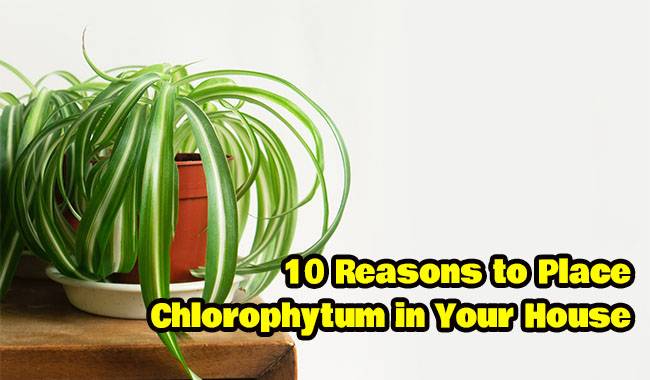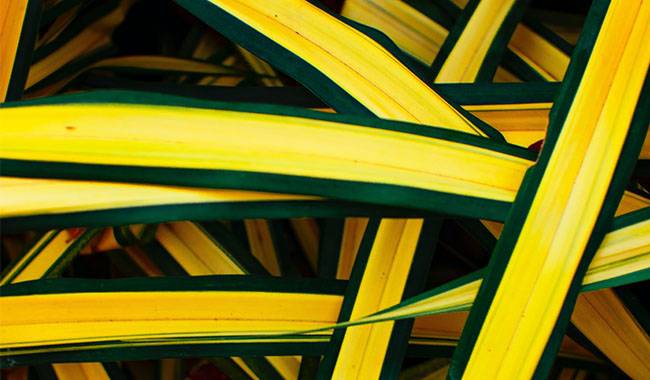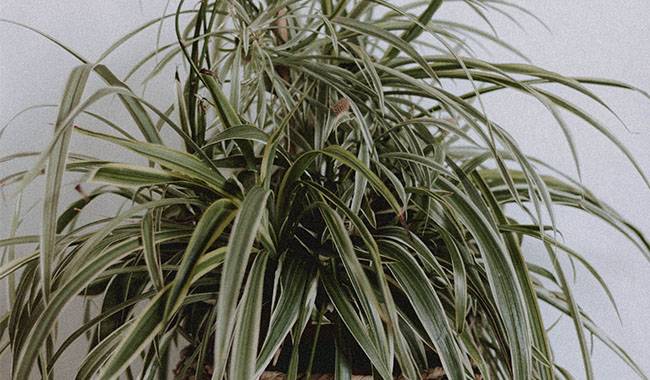
Chlorophytum is often referred to as the easiest houseplant to grow. And so it is – only in a good way. The simplicity of cultivation and propagation is matched only by clover and some succulents. Chlorophytum is undemanding, hardy, forgiving of mistakes, and can grow in almost any condition. Chlorophytum’s ornamental qualities are often forgotten, and the newer varieties, easy to control and versatile, are also unique. This plant is simply everyone’s true radiant-proof plant, with an enviable appearance and growth rate. You will learn 10 Reasons to Place Chlorophytum in Your House in the ThumbGarden article.
Chlorophytum is a fast-growing plant with thickened, strong roots and only one conditional dormant period. Linear, centrally folded, brittle, thin, and very tactile leaves gather at the roots to form a lush rump. They are curved and droop in an arc.
From the center of the roots develop strong, slender, pendulous shoots that follow the curved curve of the leaves. The delicate semi-shrub bears loose panicles of small, white, very pretty flowers. As soon as flowering is over, the daughter plants begin to grow rapidly at the ends of the shoots – tiny bunches of leaves with aerial roots that can take root in the soil.
The stronger and older the plant, the greater the arc it can produce, and the more spectacular the cascading waterfall it creates.
The once humble Chlorophytum now invites you to take a closer look at new species and hybrids. After all, Chlorophytum is uniquely “striped”. The usual white-green variants compete with the more compact yellow, cream, white, and even different colored green varieties. And then there are those varieties with unusually curly leaves!
However, it is not for its decorative and versatile nature that Chlorophytum has become a perfect candidate for any interior decoration. This plant is unpretentious and resilient, even for those who move around a lot. And here are 10 of the most impressive arguments.
1. Chlorophytum plant is a super filter

If you’re looking for a potted plant that does more for indoor air, Chlorophytum is one of the first candidates. It is a unique filtering plant that purifies the air even in the kitchen.
Chlorophytum absorbs carbon monoxide, ammonia, acetone, benzene, nitrogen oxides, formaldehyde, toxins, and allergens. It single-handedly absorbs 80% of the pollutants in the air in a standard kitchen, and it only gets prettier in the process!
2. Used extensively in green design
Chlorophytum can be planted in any way you like.
- On bookshelves, tall furniture, and stands, in hanging baskets, it will display the beauty of cascading, airy, visually light, eclectic liana and large ampelas.
- In ordinary pots, Chlorophytum will create lush curtains, waterfalls, and cascades.
- In large containers, planting several plants will produce beautiful patterned arrangements.
- Will easily create walls and waterfalls – alone or in collaboration.
Chlorophytum easily “mixes” with other plants and can be grown in traditional pots and hydroponics, as well as in a variety of tanks with automatic irrigation. They are suitable for use in botanical gardens, tree gardens, greenhouses, snakes, indoor rockeries, and decorative modules for modern interiors. Chlorophytum is even used as a stylish balcony and garden plant!
3. Design for room temperature
Chlorophytum grows well at room temperature and can withstand all the heat of summer and the chill of winter-at least 59 °F (15°C), with a minimum requirement of 46-50 °F (8-10°C) for survival.
As long as the plant is not exposed to cold drafts and constant supercooling, there will be no problems. It will also do well with its owner – in the steady warmth and comfort of a living room or office.
4. Quickly adapts to light
Chlorophytum is not afraid of changes in location and adapts well to sometimes completely different conditions, especially if you give them time to adapt and don’t make too drastic a transition. Even if the mother plant is accustomed to bright light, the separated progeny can be grown as shade-loving plants and vice versa.
Chlorophytum will not survive except in dense shade and direct midday sun. This plant is capable of growing in bright diffused light and any degree of penumbra, in natural light or in full artificial light. It’s well worth a closer look – it’s easy to find the “limits” of what is acceptable from its color and growth.
There are also some nuances to always keep in mind.
- Varieties with markings lose their color in the shade (but rarely when their growth rate is affected).
- The stronger the light, the more active the chloroplast development, but more likely to keep the plant in the penumbra.
5. Pardon any lapses in care
By virtue of the ideal care of Chlorophytum, they provide.
- stable soil moisture, do not water too much or too little (in summer a lot of water every 2-3 days to dry out the topsoil, in winter – 2-3 times, less frequently).
- Fertilize regularly from May to October, 1 fertilizer per month is enough (the more fertilizer you apply, the more active Chlorophytum grows).
- Spray and shower regularly (wiping fragile leaves is not a good idea).
- Transplant annually or slightly infrequently, when the soil is full of roots, into any high-quality substrate.
But it will easily forgive some small mistakes. Once the substrate is completely dry, the plants will not lose their decorative qualities – faded and wilted shrubs can regenerate after a few weeks of drought, but this is an emergency. Chlorophytum will also forgive overwatering if the soil is allowed to dry out before the next watering.
With regular transplanting, Chlorophytum will grow and bloom without even fertilizing.
6. Growing before your eyes
Chlorophytum is one of the fastest-growing species, capable of growing several times its size in a year. Under optimal conditions, even a small baby can grow into a veritable giant in the air within a year.
Chlorophytum’s rapid growth is indispensable for creating green walls and quickly greening the interiors of offices and new homes.

7. Easy to control
If aggressive Chlorophytum growth is terrible or does not fit the interior concept, this is no reason to give up on it. Chlorophytum is easy to control.
- Cut off the arch if you don’t want the plant to grow: it may not allow Chlorophytum to produce any buds at all, or reduce the number of buds.
- by limiting watering and reducing moisture in the soil (the higher the humidity, the more aggressively it will release babies and leaves, and build up a huge root system).
- by reducing feeding.
- by lowering the temperature and lighting.
In contrast, improving all aspects of performance allows encouraging sprawl where appropriate.
8. Chlorophytum reproduces easily
Chlorophytum can grow from seed and can be divided, but the aerial rosettes are easily separated and rooted, so little else is used.
Chlorophytum’s progeny can be rooted in water, in soil, or they can be left uncut and placed in pots as scions and separated only after rooting.
9. Safe even for babies and animals
Chlorophytum is the first plant you come across in the advice on choosing plants for the nursery. It is not only safe, but it is also beneficial from all points of view. Its ability to absorb toxins and harmful substances is record-breaking. The harmonious effect on the interior is difficult to overestimate thanks to the light, the soft colors, and the shape of the clumping plants, shoots, and leaves.
Chlorophytum is an island of calm and tranquility that will help soften all sharp corners and straight lines and single-handedly replace up to five other plants.
One more important benefit: you won’t find a better species to introduce your children to plant care or to learn about plants and their propagation. Its fast growth, sturdiness, and unpretentiousness will soon produce a beautiful plant, even under less than ideal care.
10. Never gets sick
With a little care, disease and pest problems are guaranteed to be avoided. Typical pests such as scab, spider mites, and aphids are almost non-existent on this plant, and only thrips may appear on very neglected plants.
There are no diseases that can harm this unique plant, except for rot in extremely wet and cold conditions.







